
A Zeppelin is a type of rigid airship named after the German inventor Count Ferdinand von Zeppelin who pioneered rigid airship development at the beginning of the 20th century. Zeppelin's notions were first formulated in 1874 and developed in detail in 1893. They were patented in Germany in 1895 and in the United States in 1899. After the outstanding success of the Zeppelin design, the word zeppelin came to be commonly used to refer to all rigid airships. Zeppelins were first flown commercially in 1910 by Deutsche Luftschiffahrts-AG (DELAG), the world's first airline in revenue service. By mid-1914, DELAG had carried over 10,000 fare-paying passengers on over 1,500 flights. During World War I, the German military made extensive use of Zeppelins as bombers and as scouts, killing over 500 people in bombing raids in Britain.

LZ 129 Hindenburg was a German commercial passenger-carrying rigid airship, the lead ship of the Hindenburg class, the longest class of flying machine and the largest airship by envelope volume. She was designed and built by the Zeppelin Company on the shores of Lake Constance in Friedrichshafen, Germany, and was operated by the German Zeppelin Airline Company. The airship flew from March 1936 until it was destroyed by fire 14 months later on May 6, 1937 while attempting to land at Lakehurst Naval Air Station in Manchester Township, New Jersey, at the end of the first North American transatlantic journey of her second season of service. This was the last of the great airship disasters; it was preceded by the crashes of the British R38, the US airship Roma, the French Dixmude, the British R101, and the USS Akron.

Count Ferdinand von Zeppelin was a German general and later inventor of the Zeppelin rigid airships, founding the company Luftschiffbau Zeppelin.

Hugo Eckener was the manager of the Luftschiffbau Zeppelin during the inter-war years, and also the commander of the famous Graf Zeppelin for most of its record-setting flights, including the first airship flight around the world, making him the most successful airship commander in history. He was also responsible for the construction of the most successful type of airships of all time. An anti-Nazi who was invited to campaign as a moderate in the German presidential elections, he was blacklisted by that regime and eventually sidelined.

The Hindenburg is a 1975 American Technicolor disaster film based on the disaster. The film stars George C. Scott. It was produced and directed by Robert Wise, and was written by Nelson Gidding, Richard Levinson and William Link, based on the 1972 book of the same name by Michael M. Mooney.

A hangar is a closed building structure to hold aircraft or spacecraft. Hangars are built of metal, wood, or concrete. The word hangar comes from Middle French hanghart, of Germanic origin, from Frankish *haimgard, from *haim and gard ("yard").
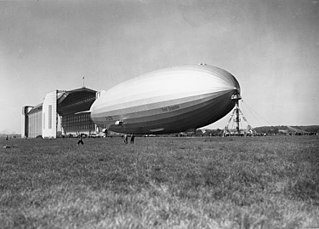
The Graf Zeppelin was the last of the German rigid airships built by Zeppelin Luftschiffbau during the period between the World Wars, the second and final ship of the Hindenburg class, and the second zeppelin to carry the name "Graf Zeppelin" and thus often referred to as Graf Zeppelin II. Due to the United States refusal to export helium to Germany, the Graf Zeppelin II was filled with hydrogen and therefore never carried commercial passengers. It made 30 flights over 11 months in 1938–39, many being propaganda publicity flights; but staff of the Reich Air Ministry were aboard to conduct radio surveillance and measurements. The airship, along with its LZ 127 namesake were both scrapped in April 1940, and their duralumin framework salvaged to build aircraft for the Luftwaffe.
Luftschiffbau Zeppelin GmbH is a German aircraft manufacturing company. It is perhaps best known for its leading role in the design and manufacture of rigid airships, commonly referred to as Zeppelins due to the company's prominence. The name 'Luftschiffbau' is a German word meaning building of airships.
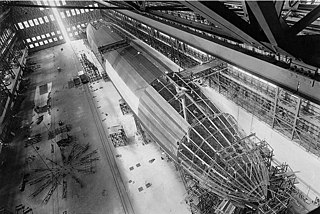
A rigid airship is a type of airship in which the envelope is supported by an internal framework rather than by being kept in shape by the pressure of the lifting gas within the envelope, as in blimps and semi-rigid airships. Rigid airships are often commonly called Zeppelins, though this technically refers only to airships built by the Luftschiffbau Zeppelin company.
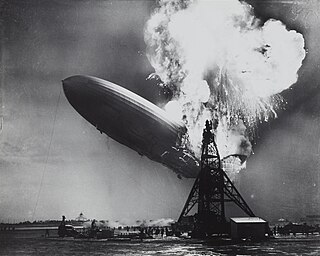
The Hindenburg disaster was an airship accident that occurred on May 6, 1937, in Manchester Township, New Jersey, United States. The German passenger airship LZ 129 Hindenburg caught fire and was destroyed during its attempt to dock with its mooring mast at Naval Air Station Lakehurst. The accident caused 35 fatalities from the 97 people on board, and an additional fatality on the ground.

Sometimes dubbed the Golden Age of Aviation, the period in the history of aviation between the end of World War I (1918) and the beginning of World War II (1939) was characterised by a progressive change from the slow wood-and-fabric biplanes of World War I to fast, streamlined metal monoplanes, creating a revolution in both commercial and military aviation. By the outbreak of World War II in 1939 the biplane was all but obsolete. This revolution was made possible by the continuing development of lightweight aero engines of increasing power. The jet engine also began development during the 1930s but would not see operational use until later.

Captain Ernst August Lehmann was a German Zeppelin captain. He was one of the most famous and experienced figures in German airship travel. The Pittsburgh Press called Lehmann the best airship pilot in the world, although he was criticized by Hugo Eckener for often making dangerous maneuvers that compromised the airships. He was a victim of the Hindenburg disaster in 1937.
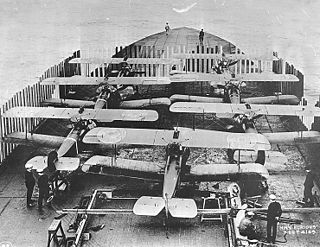
The Tondern raid or Operation F.7, was a British bombing raid mounted by the Royal Navy and Royal Air Force against the Imperial German Navy airship base at Tønder, Denmark, then a part of Germany. The airships were used for the strategic bombing of Britain. It was the first attack in history by aircraft from an aircraft carrier. On 19 July 1918, seven Sopwith Camels took off from the converted battlecruiser HMS Furious. For the loss of one man and several aircraft, the British destroyed Zeppelins, L 54 and L 60 and a captive balloon.
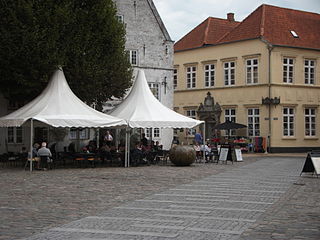
Tønder is a town in the Region of Southern Denmark. With a population of 7,491, it is the main town and the administrative seat of the Tønder Municipality.
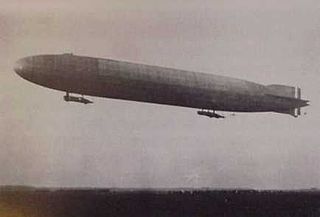
Zeppelin LZ 54, given the military tactical designation L 19, was a Zeppelin of the Imperial German Navy. While returning from her first bombing raid on the United Kingdom in early 1916, she came down in the North Sea. Her crew survived the crash, but drowned after the crew of a British fishing vessel refused to rescue them; at the time this was a widely reported and notorious incident.

Deutsche Zeppelin-Reederei, abbreviated DZR, is a German limited-liability company that operates commercial passenger zeppelin flights. The current incarnation of the DZR was founded in 2001 and is based in Friedrichshafen. It is a subsidiary of Zeppelin Luftschifftechnik and operates Zeppelin NT "Next Generation" airships. By 2009 the DZR had transported over 55,000 passengers. As of 2012 the DZR flies a schedule of 12 tour routes between March and November in Southern Germany. The company also operates flights to other selected cities as well as charter flights.
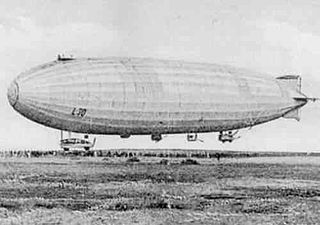
Zeppelin "L 30" was the first R-class "Super Zeppelin" of the German Empire. It was the most successful airship of the First World War with 31 reconnaissance flights and 10 bombing runs carrying a total of 23,305 kg of bombs, with the first ones targeting England, and the four final raids targeting Livonia and Ösel (Saaremaa). At the time of its construction, It was the world's largest Zeppelin, and with its 6 engines, "L 30" could reach speeds higher than 100 km/h, making it the fastest Zeppelin in the world too.
The LZ 59 was a World War I German Navy Airship and was the first Q-Class zeppelin with a then record length of 178.5 metres. It was allocated the tactical numbering L 20 and carried out a total of 19 flights, including 2 raids on England and 10 reconnaissance missions.
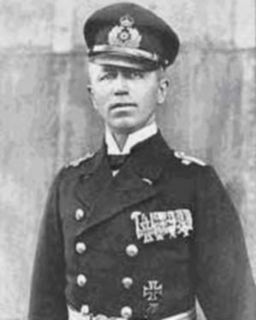
Kapitänleutnant Franz Stabbert was a Kapitänleutnant of the German Kaiserliche Marine, he is most known for being the commander of the doomed LZ 59 during the First World War.

The LZ 85, tactical number L 45, also known as Zeppelin of Laragne by the French public, was a World War I R-Class zeppelin of the German Navy that carried out a total of 27 flights, including 3 raids on England and 12 reconnaissance missions.


















